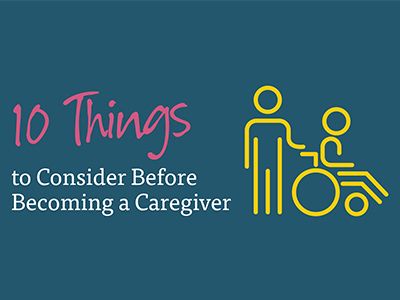It's estimated that 70 percent of people over 65 will actually need some form of long-term care – which means at some point down the road you may face several medical, financial and legal decisions for yourself or a loved one. You can make the journey a lot smoother when you take some time to plan ahead and discuss a care plan for long-term needs.
Long-term care defined
Long-term care is generally described as providing a range of services and support for someone over an extended period of time to meet their medical and personal care needs such as bathing, dressing, eating, taking medication and getting around. Long-term care might also include help with everyday tasks such as housework, errands and money management.
Because the cost of these services continues to rise, it’s a good idea to start planning, budgeting and talking now so that you are prepared when you need this support, whether it be at home, from the community, in an assisted living facility or nursing home. Here are some initial questions to consider as you map out your needs:
What kind of care will you need?
Most long-term care services assist people with what’s known as “activities of daily living," such as dressing, bathing and using the bathroom. More involved services could include medical and non-medical care for people with a chronic illness or disability. For purposes of Medicaid eligibility and payment, long-term care services are those provided to an individual who requires a level of care equivalent to that received in a nursing facility.
Where will you live?
Long-term care can be provided at home, in the community or in a facility — and your decision needs to take several factors into account such as financial resources, level of care needed and willingness to adapt to changes in lifestyle and location. Here are the main options you have, ranging from a limited amount of care provided to more skilled care:
- Independent living: These residential housing facilities may provide supportive services such as meals, housekeeping, maintenance and social activities, but require minimal or no extra medical assistance.
- Assisted living: These facilities for seniors combine housing, supportive services and healthcare, but emphasize residents’ privacy and choice.
- Nursing homes: These facilities offer extended care to people who require skilled nursing care, rehabilitation and/or help with daily living and supervision.
- Long-term care facilities (aka convalescent care facilities): These are licensed facilities that provide general nursing care to those who are chronically ill or unable to take care of daily living needs.
How will you pay?
Monthly costs for long-term care vary based on the type of care you need, the living arrangements you choose and region of the country where you live. But nationwide, the costs can range from almost $4000 for a home health aide to more than $7500 for a private room in a nursing home. For many Americans, that makes for a costly and often unplanned expense that could go on for years. Here’s a checklist of different approaches and resources, all with pros and cons, to consider.
- Long-term care insurance: Also known as nursing home insurance, this is an insurance plan designed to offer financial support to pay for long-term care services. As you plan, keep in mind that if you are older or less well, then you can expect the policy to have higher premiums and more stringent terms. On the other hand, if you are younger and in good health, you can expect more flexibility in the terms and premiums. To learn more about this option, talk to an insurance agent who specializes in these types of policies so you can get a good understanding of long-term care insurance costs.
- Government assistance: The government provides assistance for some services to those eligible for Medicare, such as nursing home rehabilitation and post-hospitalization home health care. But it doesn't address long-term chronic needs or custodial care.
- Community services: These can include adult day care, meal programs, senior centers, transportation and other services provided by state, city or local agencies, as well as faith- or community-based services.
- Your own savings and investments: It’s a good idea to save over the years as a way to help offset the costs of long-term care. Keep in mind, however, how your savings could be depleted in just a short amount of time depending on the longevity of your loved one and the potentially increasing costs and complexity of care.
Discuss the options and decide together.
Broaching the subject of long-term care with an elder or senior can be daunting and uncomfortable. But a solid assessment of the elder's needs, and an open, yet respectful discussion about those needs, is the first step to making sure your loved one gets the right care when he or she needs it. Plus, having that discussion sooner rather than later can offer him or her more control over certain decisions, and help assure you’re ready for whatever costs, changes or circumstances come your way.



